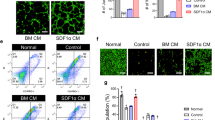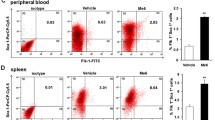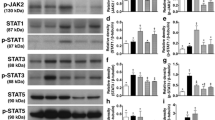Abstract
The aim of this present study is to investigate the impacts of combinatorial simvastatin administration and endothelial progenitor cell (EPC) transplantation on therapeutic angiogenesis in an athymic nude mouse model of hind limb ischemia. Athymic nude mice were divided into four groups (n = 10/group): vehicle administration plus PBS injection (control), simvastatin administration plus PBS injection (simvastatin), vehicle administration plus EPC transplantation (EPC), and simvastatin administration plus EPC transplantation (combination). The combination therapy had the greatest laser Doppler blood perfusion imager (LDPI) index and capillary density among the four groups. Importantly, this combination therapy significantly reduced apoptosis of ischemic skeletal muscle cells in part through downregulation of Bax and upregulation of Bcl-2 compared with the other groups. Moreover, the combination therapy exhibited the highest efficacy of increasing the ratio of phospho-Akt to Akt among the four groups. Taken together, the simvastatin and EPC combination therapy promotes powerful angiogenesis in hindlimb ischemia. The combination therapy not only inhibites apoptosis of ischemic skeletal muscle cells partially via downregulation of Bax and upregulation of Bcl-2, but also activates Akt phosphorylation significantly. These efficacies may be mediated by the angiogenic potency of simvastatin, EPCs, and by the beneficial effects of simvastatin on transplanted EPCs as well.







Similar content being viewed by others
References
Coppola G, Novo S (2007) Statins and peripheral arterial disease: effects on claudication, disease progression, and prevention of cardiovascular events. Arch Med Res 38:479–488
Urbich C, Heeschen C, Aicher A, Dernbach E, Zeiher AM, Dimmeler S (2003) Relevance of monocytic features for neovascularization capacity of circulating endothelial progenitor cells. Circulation 108:2511–2516
Kalka C, Masuda H, Takahashi T et al (2000) Transplantation of ex vivo expanded endothelial progenitor cells for therapeutic neovascularization. Proc Natl Acad Sci USA 97:3422–3427
Murohara T, Ikeda H, Duan J et al (2000) Transplanted cord blood-derived endothelial precursor cells augment postnatal neovascularization. J Clin Invest 105:1527–1536
Llevadot J, Murasawa S, Kureishi Y et al (2001) HMG-CoA reductase inhibitor mobilizes bone marrow–derived endothelial progenitor cells. J Clin Invest 108:399–405
Dimmeler S, Aicher A, Vasa M et al (2001) HMG-CoA reductase inhibitors (statins) increase endothelial progenitor cells via the PI 3-kinase/Akt pathway. J Clin Invest 108:391–397
Walter DH, Rittig K, Bahlmann FH et al (2002) Statin therapy accelerates reendothelialization: a novel effect involving mobilization and incorporation of bone marrow-derived endothelial progenitor cells. Circulation. 105:3017–3024
Werner N, Junk S, Laufs U et al (2003) Intravenous transfusion of endothelial progenitor cells reduces neointima formation after vascular injury. Circ Res 93:e17–e24
Assmus B, Urbich C, Aicher A et al (2003) HMG-CoA reductase inhibitors reduce senescence and increase proliferation of endothelial progenitor cells via regulation of cell cycle regulatory genes. Circ Res 92:1049–1055
Tsujimoto Y, Shimizu S (2000) Bcl-2 family: life-or-death switch. FEBS Lett 466:6–10
Tung TC, Cui G, Oshima K, Laks H, Sen L (2003) Balanced expression of mitochondrial apoptosis regulatory proteins correlates with long-term survival of cardiac allografts. Am J Physiol Heart Circ Physiol 285:H2832–H2841
Vasa M, Fichtlscherer S, Adler K et al (2001) Increase in circulating endothelial progenitor cells by statin therapy in patients with stable coronary artery disease. Circulation 103:2885–2890
Vasa M, Fichtlscherer S, Aicher A et al (2001) Number and migratory activity of circulating endothelial progenitor cells inversely correlate with risk factors for coronary artery disease. Circ Res 89:E1–E7
Murohara T, Asahara T, Silver M et al (1998) Nitric oxide synthase modulates angiogenesis in response to tissue ischemia. J Clin Invest 101:2567–2578
Shintani S, Murohara T, Ikeda H et al (2001) Augmentation of postnatal neovascularization with autologous bone marrow transplantation. Circulation 103:897–903
Nassiri SM, Khaki Z, Soleimani M et al (2007) The similar effect of transplantation of marrow-derived mesenchymal stem cells with or without prior differentiation induction in experimental myocardial infarction. J Biomed Sci 14:745–755
Jiang W, Ma A, Wang T et al (2006) Intravenous transplantation of mesenchymal stem cells improves cardiac performance after acute myocardial ischemia in female rats. Transpl Int 19:570–580
Iwase T, Nagaya N, Fujii T et al (2005) Adrenomedullin enhances angiogenic potency of bone marrow transplantation in a rat model of hindlimb ischemia. Circulation 111:356–362
Urbich C, Walter DH, Zeiher AM, Dimmeler S (2000) Laminar shear stress upregulates integrin expression: role in endothelial cell adhesion and apoptosis. Circ Res 87:683–689
Jeon O, Song SJ, Bhang SH, Choi CY, Kim MJ, Kim BS (2007) Additive effect of endothelial progenitor cell mobilization, bone marrow mononuclear cell transplantation on angiogenesis in mouse ischemic limbs. J Biomed Sci 14:323–330
Kureishi Y, Luo Z, Shiojima I et al (2000) The HMG-CoA reductase inhibitor simvastatin activates the protein kinase Akt and promotes angiogenesis in normocholesterolemic animals. Nat Med 6:1004–1010
Vasa M, Fichtlscherer S, Adler K et al (2001) Increase in circulating endothelial progenitor cells by statin therapy in patients with stable coronary artery disease. Circulation 103:2885–2890
Urbich C, Knau A, Fichtlscherer S et al (2005) FOXO-dependent expression of the proapoptotic protein Bim: pivotal role for apoptosis signaling in endothelial progenitor cells. FASEB J 19:974–976
Lim H, Fallavollita JA, Hard R, Kerr CW, Canty JM Jr (1999) Profound apoptosis-mediated regional myocyte loss and compensatory hypertrophy in pigs with hibernating myocardium. Circulation. 100:2380–2386
Olivetti G, Quaini F, Sala R et al (1996) Acute myocardial infarction in humans is associated with activation of programmed myocyte cell death in the surviving portion of the heart. J Mol Cell Cardiol. 28:2005–2016
Shyu KG, Wang BW, Hung HF, Chang CC, Shih DT (2006) Mesenchymal stem cells are superior to angiogenic growth factor genes for improving myocardial performance in the mouse model of acute myocardial infarction. J Biomed Sci 13:47–58
Madeddu P, Emanueli C, Pelosi E et al (2004) Transplantation of low dose CD34+KDR+ cells promotes vascular and muscular regeneration in ischemic limbs. FASEB J 18:1737–1739
Dai Q, Thompson MA, Pippen AM, Cherwek H, Taylor DA, Annex BH (2002) Alterations in endothelial cell proliferation and apoptosis contribute to vascular remodeling following hind-limb ischemia in rabbits. Vasc Med 7:87–91
Albert MA, Danielson E, Rifai N, Ridker PM (2001) PRINCE Investigators. Effect of statin therapy on C-reactive protein levels: the pravastatin inflammation/CRP evaluation (PRINCE): a randomized trial and cohort study. JAMA 286:64–70
Wierzbicki AS, Poston R, Ferro A (2003) The lipid and non-lipid effects of statins. Pharmacol Ther. 99:95–112
Kinnaird T, Stabile E, Burnett MS et al (2004) Local delivery of marrow-derived stromal cells augments collateral perfusion through paracrine mechanisms. Circulation 109:1543–1549
Gnecchi M, He H, Liang OD et al (2005) Paracrine action accounts for marked protection of ischemic heart by Akt-modified mesenchymal stem cells. Nat Med 11:367–368
Uemura R, Xu M, Ahmad N, Ashraf M (2006) Bone marrow stem cells prevent left ventricular remodeling of ischemic heart through paracrine signaling. Circ Res 98:1414–1421
Xu M, Uemura R, Dai Y, Wang Y, Pasha Z, Ashraf M (2007) In vitro and in vivo effects of bone marrow stem cells on cardiac structure and function. J Mol Cell Cardiol 42:441–448
Ruixing Y, Jiaquan L, Jie C, Dezhai Y (2006) Intravenous administration of vascular endothelial growth factor improves cardiac performance and inhibits cardiomyocyte apoptosis. Growth Factors 24:209–217
Nishida S, Nagamine H, Tanaka Y, Watanabe G (2003) Protective effect of basic fibroblast growth factor against myocyte death and arrhythmias in acute myocardial infarction in rats. Circ J 67:334–339
Guo J, Lin G, Bao C, Hu Z, Chu H, Hu M (2008) Insulin-like growth factor 1 improves the efficacy of mesenchymal stem cells transplantation in a rat model of myocardial infarction. J Biomed Sci 15:89–97
Dalla Libera L, Ravara B, Volterrani M et al (2004) Beneficial effects of GH/IGF-1 on skeletal muscle atrophy and function in experimental heart failure. Am J Physiol Cell Physiol 286:C138–C144
Kupatt C, Hinkel R, Lamparter M et al (2005) Retroinfusion of embryonic endothelial progenitor cells attenuates ischemia-reperfusion injury in pigs: role of phosphatidylinositol 3-kinase/AKT kinase. Circulation 112(9 Suppl):I117–I122
Dimmeler S, Zeiher AM (2000) Akt takes center stage in angiogenesis signaling. Circ Res 86:4–5
Jiang BH, Zheng JZ, Aoki M, Vogt PK (2000) Phosphatidylinositol 3-kinase signaling mediates angiogenesis and expression of vascular endothelial growth factor in endothelial cells. Proc Natl Acad Sci USA 97:1749–1753
Urbich C, Dernbach E, Zeiher AM, Dimmeler S (2002) Double-edged role of statins in angiogenesis signaling. Circ Res 90:737–744
Poynter JN, Gruber SB, Higgins PD et al (2005) Statins and the risk of colorectal cancer. N Engl J Med 352:2184–2192
Rao S, Porter DC, Chen X, Herliczek T, Lowe M, Keyomarsi K (1999) Lovastatin-mediated G1 arrest is through inhibition of the proteasome, independent of hydroxymethyl glutaryl-CoA reductase. Proc Natl Acad Sci USA 96:7797–7802
Agarwal B, Rao CV, Bhendwal S et al (1999) Lovastatin augments sulindac-induced apoptosis in colon cancer cells and potentiates chemopreventive effects of sulindac. Gastroenterology 117:838–847
Dulak J, Józkowicz A (2005) Anti-angiogenic and anti-inflammatory effects of statins: relevance to anti-cancer therapy. Curr Cancer Drug Targets 5:579–594
Brown AJ (2007) Cholesterol, statins and cancer. Clin Exp Pharmacol Physiol 34:135–141
Pedersen TR, Wilhelmsen L, Faergeman O et al (2000) Follow-up study of patients randomized in the Scandinavian simvastatin survival study (4S) of cholesterol lowering. Am J Cardiol 86:257–262
Strandberg TE, Pyörälä K, Cook TJ et al (2004) Mortality and incidence of cancer during 10-year follow-up of the Scandinavian Simvastatin Survival Study (4S). Lancet 364:771–777
Graaf MR, Beiderbeck AB, Egberts AC, Richel DJ, Guchelaar HJ (2004) The risk of cancer in users of statins. J Clin Oncol 22:2388–2394
Shepherd J, Blauw GJ, Murphy MB et al (2002) Pravastatin in elderly individuals at risk of vascular disease (PROSPER): a randomised controlled trial. Lancet 360:1623–1630
Acknowledgments
The study was supported by The Medical Science and Technology Foundation of Jiangsu Provincial Bureau of Health (No. H200508). We are grateful to Zilu Wang, Nanjing Medical University for the technical assistance.
Author information
Authors and Affiliations
Corresponding author
Rights and permissions
About this article
Cite this article
Hu, Z., Zhang, F., Yang, Z. et al. Combination of simvastatin administration and EPC transplantation enhances angiogenesis and protects against apoptosis for hindlimb ischemia. J Biomed Sci 15, 509–517 (2008). https://doi.org/10.1007/s11373-008-9243-1
Received:
Accepted:
Published:
Issue Date:
DOI: https://doi.org/10.1007/s11373-008-9243-1




